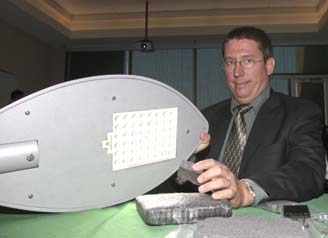 The Oak Ridge National Laboratory has licensed a graphite foam material to LED North America for use in cooling LEDs and other components in SSL luminaires.
The Oak Ridge National Laboratory has licensed a graphite foam material to LED North America for use in cooling LEDs and other components in SSL luminaires.
LED North America hopes to solve the heat problem that plaques LED-based solid-state lighting (SSL) with a new graphite foam material. Developed by the US Department of Energy's Oak Ridge National Laboratory (ORNL), the foam has a crystal structure that offers high thermal conductivity and light weight. LED North America has signed an exclusive licensing agreement to use the foam.
High temperatures can both shorten the life and impact the brightness of LEDs and virtually all luminaires require some type of heat-sink or other thermal management technology to mitigate the problem. Presumably the foam will offer far more flexibility than copper or aluminum heat sinks along with lighter weight. Moreover the thermal design can remain passive as opposed to schemes that use fans or other devices to move air.
The foam was developed by James Klett of ORNL's Materials Science and Technology Division. The graphite crystal structure in the foam is basically a network of conductive ligaments and air pockets. The ligaments will conduct heat away from LEDs in SSL applications. And the 25% density of the foam leads to the light-weight properties.
A cooling scheme is vital to SSL technology delivering on the long-life expectancy that has come along with LEDs. SSL costs more up front than other lighting technologies. Therefore the technology will only pay off if the longevity expectations are realized.
"While this technology will reduce temperatures and increase the life of the LED lighting systems, what it will really do is save municipalities millions of dollars every year in replacement fixture costs as well as maintenance," said Klett.